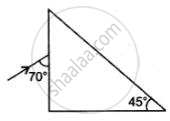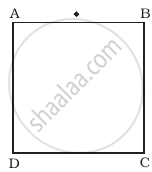Advertisements
Advertisements
Question
Which of the following is not involved in formation of a rainbow?
Options
refraction
angular dispersion
angular deviation
total internal reflection
Solution
Angular deviation
Explanation:
A rainbow is created when raindrops that are suspended in the air scatter sunlight. We perceive a rainbow because of the way light refracts when it enters a raindrop, total internal reflection from the rear of the droplet surface, and further refracted out in the atmosphere. So all the given process i.e total internal reflection, refraction, and dispersion take place in the rainbow formation. Angular deviation of light doesn't occur in the formation of a rainbow.
APPEARS IN
RELATED QUESTIONS
Which colour of light has a higher critical angle? Red light or green light.
Draw the diagram of a right-angled isosceles prism which is used to make an invented image erect
Total internal reflection occurs only when a ray of light passes from a ______ medium to a ______ medium.
Plot a graph between
Angle of incidence versus angle of reflection,
Images formed by totally reflecting prisms are brighter than the image formed by ordinary reflected light, why?
A ray of light incident at an angle of incidence ‘i’ passes through an equilateral glass prism such that the refracted ray inside the prism is parallel to its base and emerges from the prism at an angle of emergence ‘e’.
How is the angle of emergence ‘e’ related to the angle of incidence ‘i’?
What is meant by the term ‘critical angle’?
Complete the following diagram to show the path of the ray of a single colour in the diagram as if enters in and emerges out of the prism. Mark the angles wherever necessary. (Critical angle for glass = 42°).

A ray of light is incident on a glass surface at an angle of 50° with the corresponding angle of refraction 30°. Find the value of the R.I. of glass.
A ray of light is incident as a normal ray on the surface of separation of two different mediums. What is the value of the angle of incidence in this case?
Answer the following question.
Explain ‘mirage’ as an illustration of refraction.
Answer the following question.
Define the critical angle of incidence and obtain an expression for it.
Critical angle of light passing from glass to air is maximum for ____________.
For total internal reflection to take place, the angle of inddence i and the refractive index µ of the medium must satisfy the inequality ____________.
Optical fibre communication uses the principle of ______.
The outer concentric shell in optic fiber is called ______.
Optical Fibres are based on the phenomenon of dispersion.
The angle of incidence at which the angle of refraction is Q£ is called the critical angle.
What is the phenomenon used in optical fiber? Explain.
A rectangular block of glass ABCD has a refractive index 1.6. A pin is placed midway on the face AB (Figure). When observed from the face AD, the pin shall ______.

- appear to be near A.
- appear to be near D.
- appear to be at the centre of AD.
- not be seen at all.
A Rainbow is a beautiful natural phenomenon formed because of the following:
A light is entering from one medium refractive index `("RI" =5/3)` to another medium at an angle 30°. The angle of refraction for other medium is sin-1 `(5/6)`. then the increase in angle of incidence is ______ such that the ray of light reflected back into the same medium.
A given ray of light suffers minimum deviation in an equilateral prism P. Additional prism Q and R of identical shape and of the same material as P are now added as shown in the figure. The ray will now suffer ______.

The angle made by incident ray of light with normal of the reflecting surface is called ______.
Name any two phenomena which take place in the formation of a rainbow.
State two differences between normal reflection and total internal reflection.
